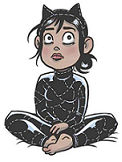One of the first electrical tattoo machines in action:
|
|
|
|
|

|
| # ? May 14, 2024 19:13 |
|
Alhazred posted:One of the first electrical tattoo machines in action: That's some awesome old school ink and a great marker of "where the judge can't see them" at the time.
|
|
|
|
Rutibex posted:I don't think its a stereotype about poetry in particular, but intellectuals. Writing poems is something city clicker nerds do, not like us simple country folk who just need to bring in the harvest. I was tempted to make a joke like "men get a paying job as a song writer instead of writing books of poetry" but have no stats on it beside it seeming like every pop-mill is full of male writers. I'm legitimately interested in the question though. Someone had to have done a sociology thesis on it right?
|
|
|
tribbledirigible posted:That's some awesome old school ink and a great marker of "where the judge can't see them" at the time. Tattoos weren't always associated with the lower class. King Frederick IX of Denmark for example had several tattoos and weren't afraid of showing them: 
|
|
|
|
|
I think that was a manhood/"real sailor" thing tho Like compare the danish Frauenzimmer tattoo register or whatever you can call it: http://runeberg.org/damtatover/0017.html In the text, he gets real into how permenantly scarring your body or whatever is a totally insane choice that nobody would even make. not even the king, man, wtf, dont gently caress around with jokes like that
|
|
|
Powaqoatse posted:I think that was a manhood/"real sailor" thing tho Not really, this illustration for example shows a woman tattooing another woman: 
|
|
|
|
|
Alhazred posted:Not really, this illustration for example shows a woman tattooing another woman: Right, tattoos were so boringly common that a publication sent a dude to draw a picture of it.
|
|
|
|
Alhazred posted:Not really, this illustration for example shows a woman tattooing another woman: "Police Gazette"  I guarantee 100% the woman in that pic is a prostitute, and would be interacting with sailors on a regular basis. Not a typical 19th century woman at all.
|
|
|
|
Yeah, when you see a woodcut or pen/ink drawing from that era of a woman lounging in that position with a low-cut dress, it's showing she's a prostitute without having to caption it 'A Whore'
|
|
|
Rutibex posted:"Police Gazette" How about Winston Churchill's mother then? She had a snake tattooed on her wrist: 
|
|
|
|
|
Bored aristocrat hipsters appropriating lower class culture.
|
|
|
|
Lady Randolph Churchill lived a pretty risqué life, though.
|
|
|
|
Amazing woman, she was An American and a Rich American by jove. This allowed her far more social freedom than the British aristocrats she was surrounded with, and my good god did she ever take advantage of this fact.
|
|
|
|
Alhazred posted:How about Winston Churchill's mother then? She had a snake tattooed on her wrist: Churchil's mum & Frederick IX are outliers is what im saying.
|
|
|
|
Powaqoatse posted:Churchil's mum & Frederick IX are outliers is what im saying. Tattoos were a huge fad among the European upper classes in the late 19th century and by ~1890 it had spread to the US. Around 1900 The New York World newspaper estimated that over half of society woman had a tattoo. By 1920 the fad was totally dead and tattooed woman were only seen in circuses. Sweevo has a new favorite as of 20:25 on Dec 4, 2016 |
|
|
|
Because everyone loves weaponry-based fun facts: Highwaymen and guerillas (particularly during the Russian Revolution) needed a reliable gun that could be used at close quarters, but all they had were old Mosin Nagant rifles, which are nearly 6 feet long. So, in typical Russian engineering fashion, they would cut the stock and most of the barrel off with hacksaws and turn them into pistols. To create a pistol that would fire rifle rounds. Their accuracy could be measured in double-figure feet, fired close enough the muzzle flash would set the target on fire, the recoil was liable to break your wrist, and they were still bolt-action and so, had to be reloaded manually after every shot, but when all you're trying to do is put a good-sized hole in your bourgeoisie of choice, it certainly worked.
|
|
|
|
Speaking of highwaymen, one of the most famous one was John "Swift Nick" Nevinson. He earned his nickname when he robbed a traveler in Kent. He then hauled rear end and rode to York where he made sure that everyone including the Lord Mayor was aware of him. When he was arrested he was found not guilty because no one believed it was possibly to travel so fast. According to legend it was king James who gave him the nickname.
|
|
|
|
|
Gyro Zeppeli posted:Because everyone loves weaponry-based fun facts: This reminds me of the knock off pistols made by the communists in China (though that Russia gun is much more bad rear end, like "That Gun" from Fallout): https://www.youtube.com/watch?v=4HNaB7l2GQk
|
|
|
|
Gyro Zeppeli posted:Because everyone loves weaponry-based fun facts: Just to be clear this is all hyperbole and that is a photoshop. They were called Obrez and you can find plenty of pictures of real ones on google.
|
|
|
|
https://youtu.be/C9jScOyH7TM This guy has iron wrists and must be fireproof too
|
|
|
|
I don't think "breaks wrists" is quite the right way to describe it: https://youtu.be/rQ_cAdufp_E
|
|
|
|
|
Powaqoatse posted:I think that was a manhood/"real sailor" thing tho Ye Olde 1891 Anime Schoolgirl Tattoo.
|
|
|
canyoneer posted:https://youtu.be/C9jScOyH7TM What is he made outta, cookie dough?
|
|
|
|
|
Does anyone have any further stories about women and tattoos? As someone who is a woman with tattoos, I've always been interested in their history - design, acceptability, etc.
|
|
|
|
Alhazred posted:Speaking of highwaymen, one of the most famous one was John "Swift Nick" Nevinson. He earned his nickname when he robbed a traveler in Kent. He then hauled rear end and rode to York where he made sure that everyone including the Lord Mayor was aware of him. When he was arrested he was found not guilty because no one believed it was possibly to travel so fast. According to legend it was king James who gave him the nickname. The ride itself is famous, but I think most people assume it was Dick Turpin who did it.
|
|
|
|
Wheat Loaf posted:The ride itself is famous, but I think most people assume it was Dick Turpin who did it. Now him I know all about.
|
|
|
|
RenegadeStyle1 posted:I actually have a question, I see a lot of "heroes" from the past were considered poets or at least wrote poems. I am assuming poetry wasn't always considered feminine or wimpy. When and why did that change to the current stereotypes about poetry? Does anyone know? Fun fact: the modern system of American fraternities exists because of a disagreement over poetry. The first US frat was (supposedly) broken up into two separate ones when two of it's members got into a long feud over who was the best poet.
|
|
|
Wheat Loaf posted:The ride itself is famous, but I think most people assume it was Dick Turpin who did it. Well, those people are wrong then: https://en.wikipedia.org/wiki/John_Nevison
|
|
|
|
|
Until WWII, fabric and clothes were one of the biggest expenses a person had. This is clear from the size of old closets--they aren't made to hold a good many things, unlike today's massive, room-sized sartorial temples. Pre Industrial Revolution, all cloth was made by hand, on a loom. All the women of a household, even the wealthy and noble ones, were involved in the manufacture of textiles in some capacity. From owing wool-producing animals like sheep or goats or keeping land in flax or cotton, maintaining small manufacturies where people made fabric, to demonstrating her abilities with a needle by embroidering 'samplers' or shifts, princesses and queens were expected to know how to sew by themselves while contributing to a kingdom's textile production. When she was still a princess, Elizabeth I embroidered some pillow covers and other gifts for her father Henry VIII's upcoming marriage to Katherine Parr. The word 'distaff' is sometimes used to indicate a female line, ie the distaff side of a family. The name comes from a distaff, a spinning tool used to keep fibers tangle-free while pulling the yarn, or thread, out on a spindle. The manual one is usually three feet long, while the one on a spinning wheel is much shorter. It's been a symbol of female power for centuries, prominent in art and mythology.
|
|
|
|
To be honest, I learned most of what I know about history from reading nothing but Horrible Histories books when I was in school.
|
|
|
Khazar-khum posted:Until WWII, fabric and clothes were one of the biggest expenses a person had. This is clear from the size of old closets--they aren't made to hold a good many things, unlike today's massive, room-sized sartorial temples. Clothing also rarely got thoroughly washed until around the 19th century because of the harsh ingredients used in cleaning, like lye. Dye tended to be easily washed out, hence the faded and dull colors typical of well-worn garments (or completely undyed fabric of peasants). The expense of clothes also meant that only the wealthy could afford multiple outfits for most of history, with the average person having one or two outfits that they used all the time. Men also got off-the-rack clothes in standard sizes much earlier than women (the early 19th century instead of the turn of the 20th century) because cultural standards in Europe and the United States for men allowed them to wear much simpler outfits, where each individual piece could be bought in a standard "good enough" size and combined. Women were expected to wear carefully tailored and complex outfits until the 1910s and 1920s, so they would simply modify their existing clothes as necessary to fit the fashion of the year.
|
|
|
|
|
We like to ridicule synthetic fabrics now, but they were a miracle back in the '20s and '30s when they first started appearing. Yes, they had and have many properties inferior to natural fibers, but they were cheap and available, and held dyes. Suddenly everyone could have long-lasting, colorful clothing and it marked a significant societal change. The arrival of polyester, particularly, was significant. Wash-n-wear, permanent pressed, no-iron clothes meant an entire day of a housewife's weekly grind was eliminated. I've seen some articles connecting polyester fabrics with the rise of the Women's Liberation movement, as women suddenly had free time and decided they'd like some more, or even work a job outside the house.
|
|
|
|
I've heard the same thing attributed to the clothes washer.
|
|
|
Deteriorata posted:We like to ridicule synthetic fabrics now, but they were a miracle back in the '20s and '30s when they first started appearing. Yes, they had and have many properties inferior to natural fibers, but they were cheap and available, and held dyes. Suddenly everyone could have long-lasting, colorful clothing and it marked a significant societal change. A lot of the things people denigrate today were regarded as downright miracles when they were new. 1950s American cuisine tends to involve a ton of canned food and later cookbooks extol the virtues of the microwave, as these space age technologies were modern wonders: canned goods were viewed as a healthy, scientific option without the filth of fresh fruits and vegetables straight from the farm and a major time saver (just dump the can in the pot instead of chopping vegetables and adding stock and gravy yourself!). Today canned goods and microwaves are the quintessential option for poor people who eat lovely food and everyone is flipping their lids about being natural and organic. Ironically, canned and frozen vegetables really do maintain more of the nutrients than fresh ones for most consumers, as the "fresh" vegetables you buy from the grocery store have typically been frozen and sat around for a while during transport from the farms instead of being rapidly preserved. If you're hard up about eating as healthy as possible with fresh vegetables, you'll want to get them as close to the source as possible.
|
|
|
|
|
My grandma is 90 and grew up in the north yorkshire farming community. This means they were about 50 years behind city folk, no electricity or indoor plumbing and the like. Monday was wash day, all the women in the family would go to the matriarchs house and would all wash clothes outside together with one woman running in and out of the house with more hot water and another running to the well and back. Tuesday was drying and ironing day. Wednesday was ironing day if it wasn't all done and dry on the Tuesday Thursday was Market day. Friday was baking day. In my grandma's family there were 6 sisters and they all clubbed in to buy a singer (!) sewing machine which was shared. The women and girls would get an "Easter dress" which included new shoes, white socks, new hat and a ribbon(!) to wear to church at easter, this was the only new (e. best dress, they had simple cotton frocks for every day) dress they got all year, if you were really lucky and were the youngest you got the hand me down Easter dresses (not the ribbons though, never the ribbons). My Grandma was the eldest and 80 years on she still thinks it was unfair. The men folk would get up with the light, be given a brown paper bag with bread and dripping and a bit of fruit or a slice of pie depending on the season, and if they were really lucky some cheese and would head off out into the fields for a day of horrible backbreaking manual labour. Children would help the adults as soon as they were able, younger boys might get to go to school so they could learn to read and write and do basic addition and subtraction so they could do the books. Girls were pretty much their mother's apprentices. My great-grandmother who was the matriarch to end all matriarchs reportedly once said "some of my boys could do the reading and all of my children had their own boots" which was an amazing achievement, made even greater by the fact that all of her 8 children have lived to a grand old age apart from a son who stole a village boy's ID to go join the war and was killed. learnincurve has a new favorite as of 17:00 on Dec 5, 2016 |
|
|
|
Deteriorata posted:I've seen some articles connecting polyester fabrics with the rise of the Women's Liberation movement, as women suddenly had free time and decided they'd like some more, or even work a job outside the house. Just wanted to add: middle and upper-class women. Working class women always had jobs (although their home could often be their place of work).
|
|
|
|
learnincurve posted:horrible backbreaking manual labour 
|
|
|
Khazar-khum posted:Until WWII, fabric and clothes were one of the biggest expenses a person had. This is clear from the size of old closets--they aren't made to hold a good many things, unlike today's massive, room-sized sartorial temples. This clothe shortage also lead to people wearing zoot suits being attacked because it was seen as unpatriotic to wear that much clothes. Of course, the fact that was primarily african-americans and latin-americans who wore it probably wasn't completely irrelevant,
|
|
|
|
|
I love Horrible Histories.
|
|
|
|

|
| # ? May 14, 2024 19:13 |
Alhazred posted:This clothe shortage also lead to people wearing zoot suits being attacked because it was seen as unpatriotic to wear that much clothes. Of course, the fact that was primarily african-americans and latin-americans who wore it probably wasn't completely irrelevant, I'd probably argue that the race of the victims in the Zoot Suit Riots was secretly the predominant factor and "They're wasting fabric!" was an excuse to downplay the racism.
|
|
|
|





































